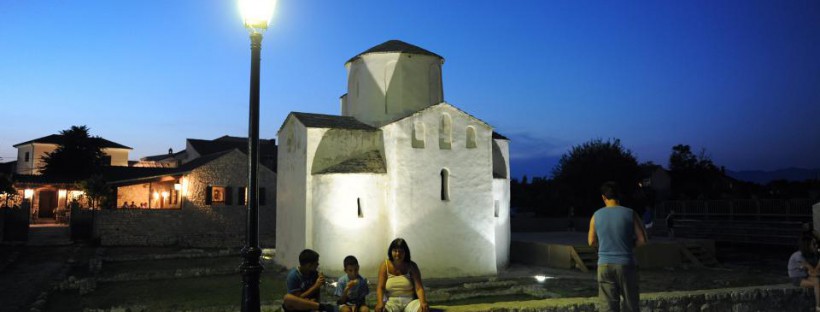An incredible blend of the three thousand years old town of Nin’s rich culture and history offers many reasons to visit this place;
visitors have a hard time fathoming how such a small place can be a stage for so many sensational historical narratives and attractions – hundred year old saltworks, producing unique Nin fleur de sel are located here, many different rulers reigned the area, back in the 9th century the town had a fleet consisting of 20 thousand rowers, and so on.
However, Nin has one story which has almost shyly emerged in the last few years – an event called the Sun and Light Festival held at the Church of the Holy Cross – a first-class medieval miracle, that we hope the Nin Tourist Board will more effectively present to their visitors in the following years.
The Church of the Holy Cross, built in the 9th century, is a pre-Romanesque Old Croatian church with a layout that seems as if its constructors were almost uneducated as all the proportions are irregular and asymmetrical.
Precise irregularities
However, the crooked walls and slanted windows were no result of wrong measurements, ignorance and clumsiness of the Old Croatian church’s constructors, but quite the opposite, really – they were creating a true masterpiece: the church of the Holy Cross in Nin was built based on very precise astronomical measures, so that the first rays of the Sun which shines over Mount Velebit through the window on the day of the spring and autumn equinox (the time when, twice a year, the Sun’s rays illuminate the Earth’s equator at a right angle) create a diagonal line in the rectangle located inside the church. The same goes for the solstice – in the summer and winter solstice, the Sun’s rays have an exact place in the church’s layout. This means that the layout of the Church of the Holy Cross in Nin is not irregular by chance and that it is very precise in its “irregularity”.
Apart from that, the church does not strictly face the East – West direction, neither does it exceed an angle of 33 degrees to the left and right of the east side, as we designate the positions of solstice points on the horizon by this angle! These points mark the longest and shortest days of the year and in Christian calendar, these days are associated with special holidays.
So, we might say that the Church of the Holy Cross in Nin is a very precise timer, a sundial. The constructor who lived before the 12th century knew exactly how to make a layout of the church to be able to tell what time it is in wintertime and summertime, knew where to make openings in the church through which sun rays would pass and show the time. As incredibly as it sounds, this church is in fact a gnomon or a part of a sundial that casts a shadow, the pointer, from Greek “one that knows or examines”.
The smallest cathedral in the world
To celebrate this peculiar trait of Old Croatian churches, six years ago, the Nin Tourist Board organised the first Sun and Light Festival in the Church of the Holy Cross, an edifice that has arms (the layout of the church is in shape of a cross with identical arm lengths) which are barely eight and a half metres long. That may be the reason why the church is also referred to as “the smallest cathedral in the world”, as it was built in a town which was in the 9th century one of the centres of medieval Croatia and the seat of the first Croatian bishop. During the reign of Croatian national rulers, Nin was also the first centre of Glagolitism in Croatia as well as an important war and trading port.
On 21 July of this year, numerous visitors gathered for the Sun and Light Festival to observe the position of sun rays at the moment of solstice at 6.38 pm. “A Number out of Light”, a short film by Bruno Gamulin, narrates a story about how scientific, astrological and archaeological research proved that the Church of the Holy Cross was built in Nin in the 9th century strictly following astronomical measures and the Sun’s entry rays in different seasons, and how Old Croats used it as a sundial and a device for measuring days, months and seasons. This correlation of a Pre-Romanesque edifice and movement of constellations paints a completely different picture about the knowledge our ancestors possessed back then – which is also successfully pointed out by the Sun and Light Festival.
THE MAGIC CREATED TO DISAPPEAR
Nin has this year added another gem to its several already existing authentic and unique stories and festivals – the Sand Festival. It was inspired by Nin’s many sandy beaches, stretching over eight kilometres along the town’s coast. The local tourist board called it “the magic created to disappear” and invited some famous sculptors who will on Saturday, 15 August, give their assistance to each festival participant in creating the most beautiful sculptures. The goal is to build replicas of Nin’s famous churches, including “the smallest cathedral in the world” on the town’s sandy beaches, alongside some other Nin landmarks, such the large sculpture of Grgur Ninski. The organizers have secured awards for best sculptures and said that their long-term goal is for the Sand Festival to gain international character and attract artists from around the world to Nin’s lagoons once a year.




